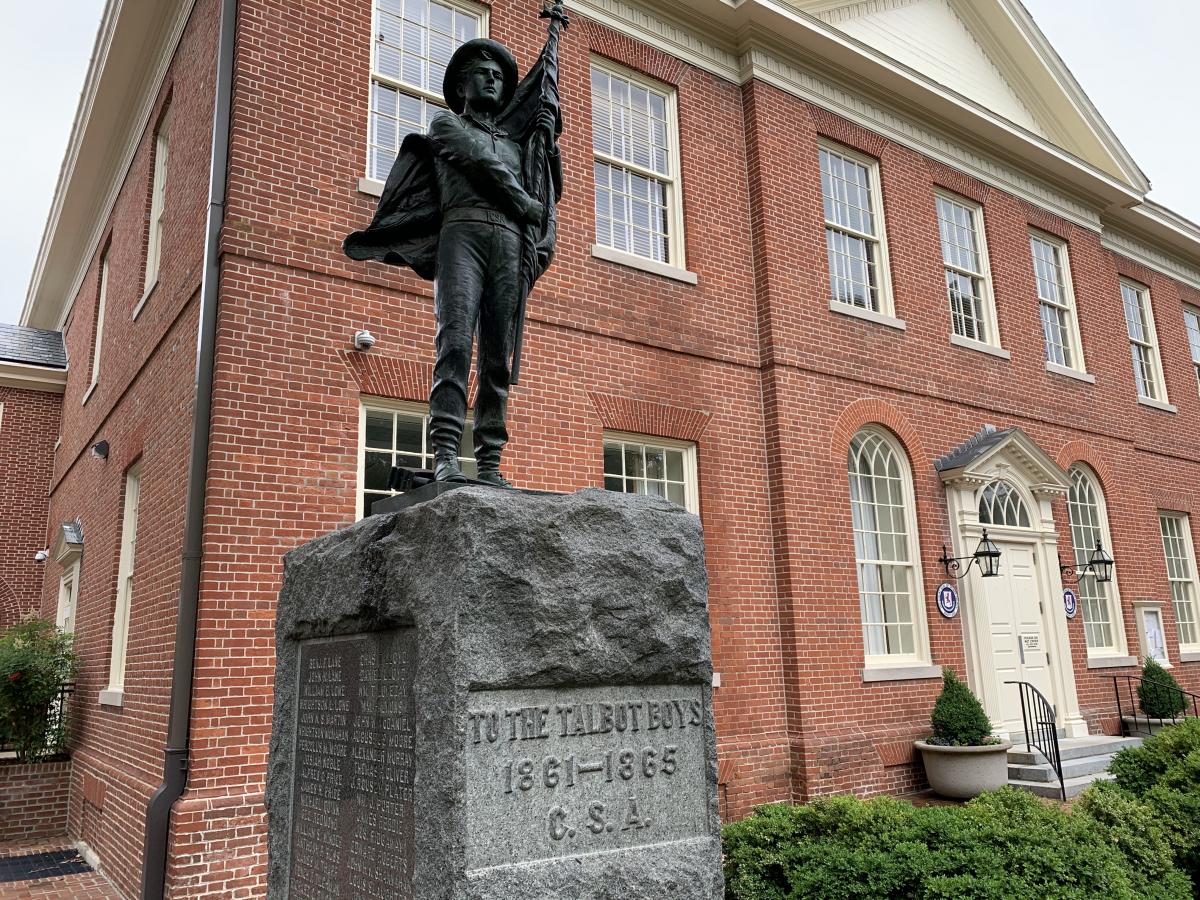Easton’s historic district commission voted unanimously Monday night to allow the removal of the Confederate monument from the county courthouse square.
The Easton Historic District Commission voted 7-0 in favor of a certificate of appropriateness that will allow Talbot County to remove and relocate the monument.
Commission members noted the town’s historic district guidelines have little guidance on statues, but a national historical preservation organization supports removal of Confederate monuments from public spaces.
The monument outside the entrance to the Talbot County Court House is believed to be the last Confederate monument on public property in Maryland.
Attorney Dan Saunders, representing Talbot County, said a majority of the Talbot County Council had determined it was in the best interest for public health, safety, and welfare to move the monument from the courthouse grounds
“The statue is on county land. It is controversial. It is divisive sadly,” Saunders said. “And it is hurtful to certain citizens of the county. So the county council has made this determination…. They are the elected officials charged with making that kind of public policy decision. And it would not be inappropriate for this body to give some deference to their thought process….”
“Because it’s controversial, it needs to be someplace where people can choose to go see it or choose not to go see it, not in a place where they have to go see it in order to conduct the business that is conducted at the courthouse,” he said.
Three residents spoke against removing the statue.
Lynn Mielke said statues for Talbot County’s Confederate and U.S. troops were erected in 1884 and 1888, respectively, at Culp’s Hill at the Gettysburg battlefield.
After the county’s Civil War veterans visited Gettysburg in 1913 for the 50th anniversary of the battle — and no doubt saw the two statues, Mielke said — efforts began to raise funds for Confederate and Union monuments at the courthouse.
The Confederate monument was funded and built; the Union one was not but a new fundraising effort is underway for such a monument, she said.

A rendering of a proposed monument to Talbot County residents who fought for the United States during the Civil War. The proposal also would include informational plaques about Talbot County’s role in the Civil War.
“108 years later a group, Build the Union Talbot Boys, has investigated, designed, and begun to raise money for a Union Talbot Boys companion monument to complement the Talbot Boys in gray monument, with informational plaques, to make a complete statement on the courthouse lawn about Talbot County’s unique role in the Civil War, (including) the Talbot Boys, the Union Talbot Boys, the USCT (United States Colored Troops), including the Unionville 18, and Frederick Douglass,” Mielke said.
“The Talbot Boys memorial is is not a memorial to traitors,” Mielke said. “And it is not a memorial to non-veterans.”
Clive Ewing noted that the town’s historic district booklet includes two photos of the Confederate monument.
He said the county council’s resolution removing the monument only refers to the statue and argued that language doesn’t include the monument’s base.
David Montgomery, president of Preserve Talbot History, said moving the monument 200 miles away “to a battlefield in the Shenandoah Valley” does not help tell the story of Talbot County’s divided loyalties during the Civil War.
Commissioner Grant Mayhew said the historic district commission should look at guidance from the National Trust for Historic Preservation.
The National Trust issued a statement about Confederate monuments after the murder of George Floyd by a Minneapolis police officer sparked protests “in support of racial justice and equity.”
In its June 18, 2020, statement, the National Trust said:
“This nationwide call for racial justice and equity has brought renewed attention to the Confederate monuments in many of our communities. The National Trust for Historic Preservation has previously issued statements about the history and treatment of Confederate monuments, emphasizing that, although some were erected — like other monuments to war dead — for reasons of memorialization, most Confederate monuments were intended to serve as a celebration of Lost Cause mythology and to advance the ideas of white supremacy. Many of them still stand as symbols of those ideologies and sometimes serve as rallying points for bigotry and hate today. To many African Americans, they continue to serve as constant and painful reminders that racism is embedded in American society.
“We believe it is past time for us, as a nation, to acknowledge that these symbols do not reflect, and are in fact abhorrent to, our values and to our foundational obligation to continue building a more perfect union that embodies equality and justice for all. We believe that removal may be necessary to achieve the greater good of ensuring racial justice and equality.
“And their history needs not end with their removal: we support relocation of these monuments to museums or other places where they may be preserved so that their history as elements of Jim Crow and racial injustice can be recognized and interpreted.
“We recognize that not all monuments are the same, and a number of communities have carefully and methodically determined that some monuments should be removed and others retained but contextualized with educational markers or other monuments designed to counter the false narrative and racist ideology that they represent, providing a deeper understanding of their message and their purpose.
“Our view, however, is that unless these monuments can in fact be used to foster recognition of the reality of our painful past and invite reconciliation for the present and the future, they should be removed from our public spaces.”

